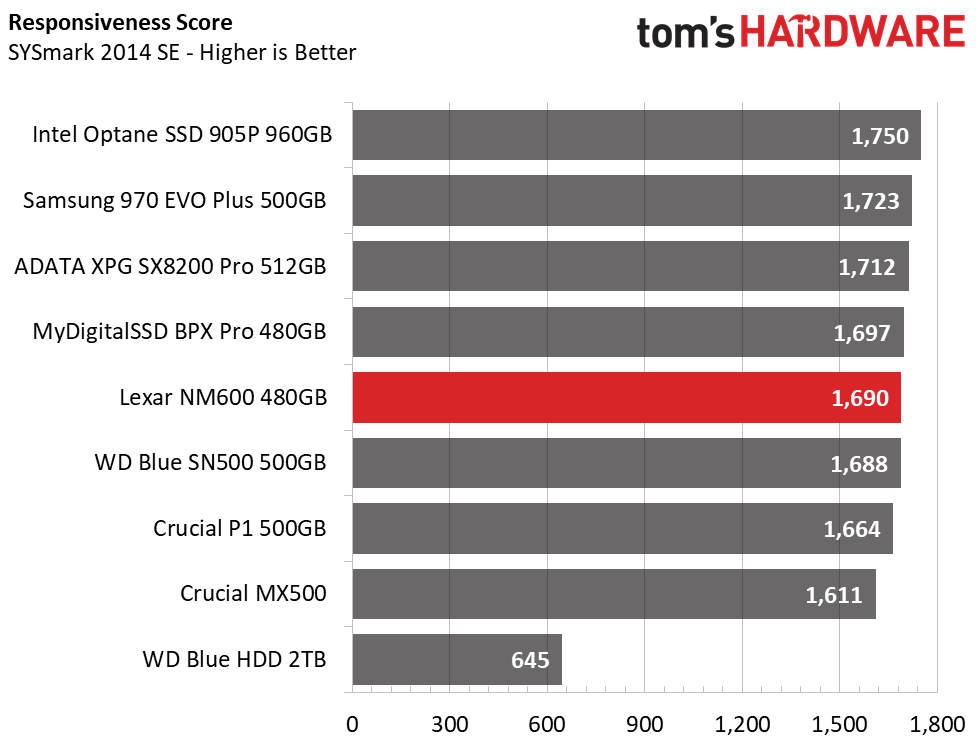Lexar NM600 M.2 NVMe SSD Review: Affordable and Efficient
Why you can trust Tom's Hardware
512GB Performance Results
Comparison Products
Today, we pit a few entry-level and mainstream competitors against Lexar’s NM600. As one of the fastest and most expensive M.2 options, we’ve included the Samsung 970 EVO Plus which features Samsung’s latest 9xL 3D V-NAND and the Phoenix penta-core NVMe controller. Additionally, featuring SMI’s SM2262EN NVMe controller and Micron 64L TLC NAND flash we’ve included ADATA’s XPG SX8200 Pro, alongside the MyDigitalSSD BPX Pro, which is built on Phison’s E12 controller and Toshiba’s BiCS3 64L TLC NAND flash.
As entry-level competition, we included the WD Blue SN500, which has an in-house NVMe controller and BiCS3 flash, as well as Crucial’s P1 drive, which utilizes the SM2263EN controller and Micron’s 64L QLC NAND flash. We also tossed in the Crucial MX500, a top-value SATA-based SSD on the low end, alongside the Intel Optane 905P on the high end, as well as a WD Blue hard drive in some tests.
Game Scene Loading - Final Fantasy XIV
The Final Fantasy XIV StormBlood benchmark is a real-world game benchmark that easily and accurately compares game load times without the inaccuracy of using a stopwatch.
Lexar’s NM600 offers great read performance for games. With a total load time of 19.10 seconds, the NM600 easily beats the plain old HDD. Beyond that, it outperforms the entry-level SSDs in the test pool and even the MyDigitalSSD BPX Pro, but is slightly behind the top-end SSDs here.
Transfer Rates – DiskBench
We use the DiskBench storage benchmarking tool to test file transfer performance with our own custom 50GB block of data. Our data set includes 31,227 files of various types, like pictures, PDFs, and videos. We copy the files to a new folder and then follow up with a reading test of a newly-written 6.5 GB file.


Again, the NM600 outperforms the entry-level SSDs in our comparison pool and absolutely decimates the Crucial MX500 in copying our test folder. When it comes to reads, its performance is very competitive and bests the other entry-level SSDs again. However, its DRAMless design is outpaced by the DRAM-based Samsung and ADATA drives.
Trace Testing – PCMark 8 Storage Test 2.0
PCMark 8 is a trace-based benchmark that uses Microsoft Office, Adobe Creative Suite, World of Warcraft, and Battlefield 3 to measure the performance of storage devices in real-world scenarios.
Get Tom's Hardware's best news and in-depth reviews, straight to your inbox.


Among the entry-level SSDs, WD’s Blue SN500 takes a lead in PCMark 8. But all, including the NM600, trail the mainstream competitors. The NM600 still delivers performance that's better than the MX500 and again, it outperforms the Crucial P1. Overall, the Lexar drive lands in 6th place.
SYSmark 2014 SE
Like PCMark, SYSmark uses real applications to measure system performance. SYSmark takes things much further, however. It utilizes fourteen different applications to run real workloads with real data sets to measure how overall system performance impacts the user experience. BAPCo's SYSmark 2014 SE installs a full suite of applications for its tests, which includes Microsoft Office, Google Chrome, Corel WinZip, several Adobe software applications, and GIMP. That also makes it a great test to measure the amount of time it takes to install widely-used programs after you install a fresh operating system.
When it comes to responsiveness, Lexar’s NM600 is just as responsive as its DRAM-based competition. Overall, it attains a few points less than the MyDigitalSSD BPX Pro and edges above the WD Blue SN500 for 5th place here.
Trace Testing – SPECworkstation 3
Like PCMark 8, SPECworkstation 3 is a trace-based benchmark, but it is designed to push the system harder by measuring workstation performance in professional applications. The full suite consists of more than 30 workloads, but we've opted to only run the storage benchmark which uses only 15 of them and categorizes the results into 5 market segments for scoring: Media & Entertainment, Product Development, Life Sciences, Energy, and General Operations.

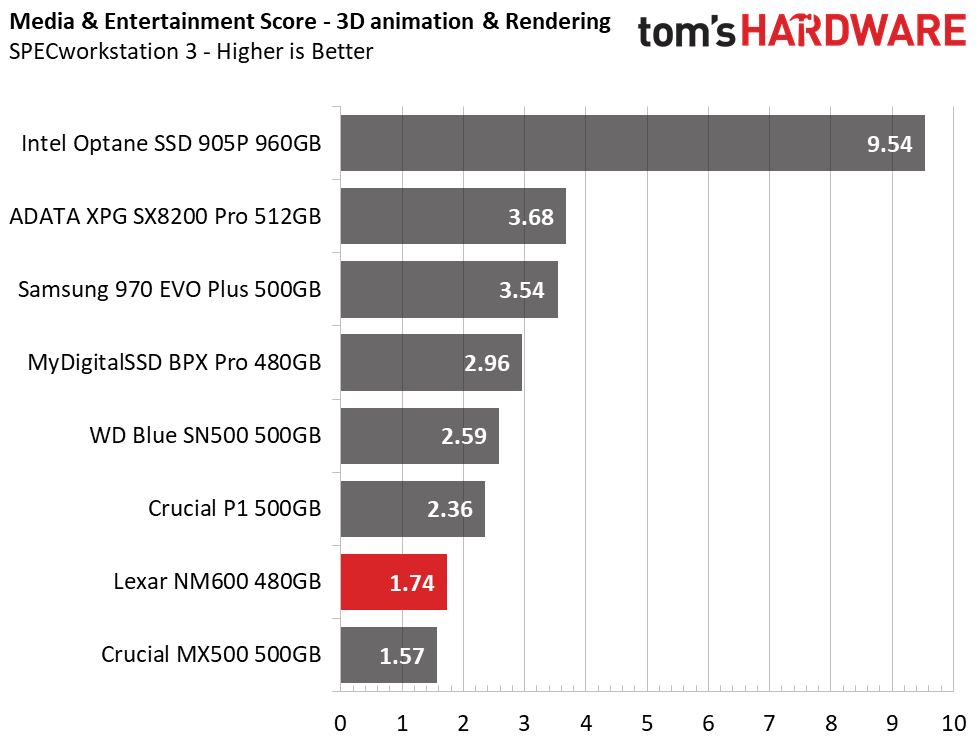

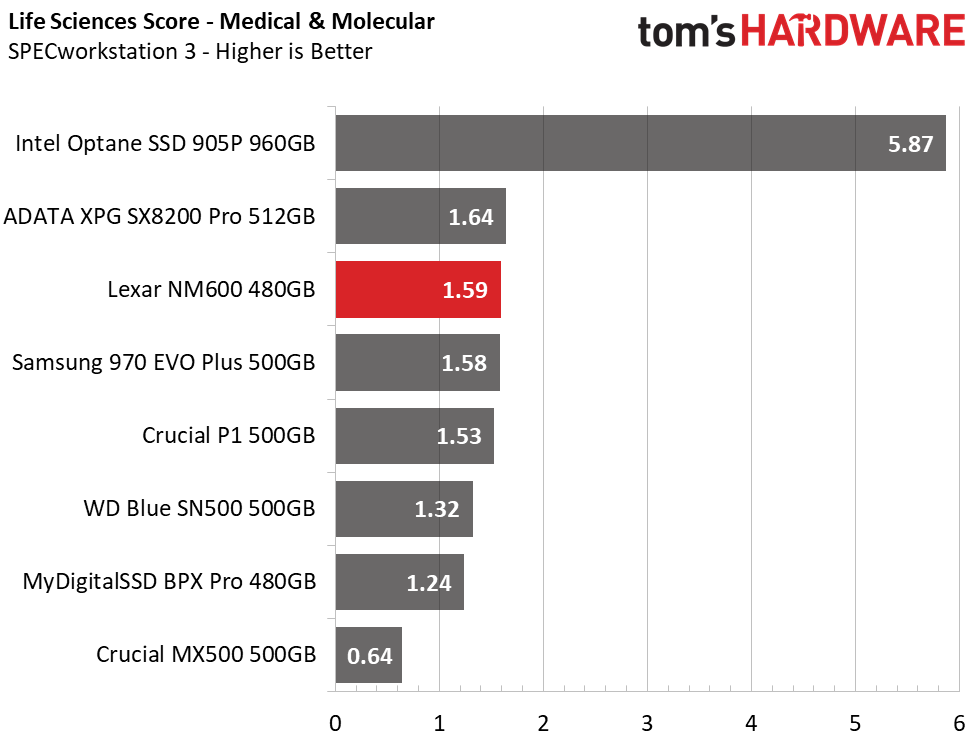
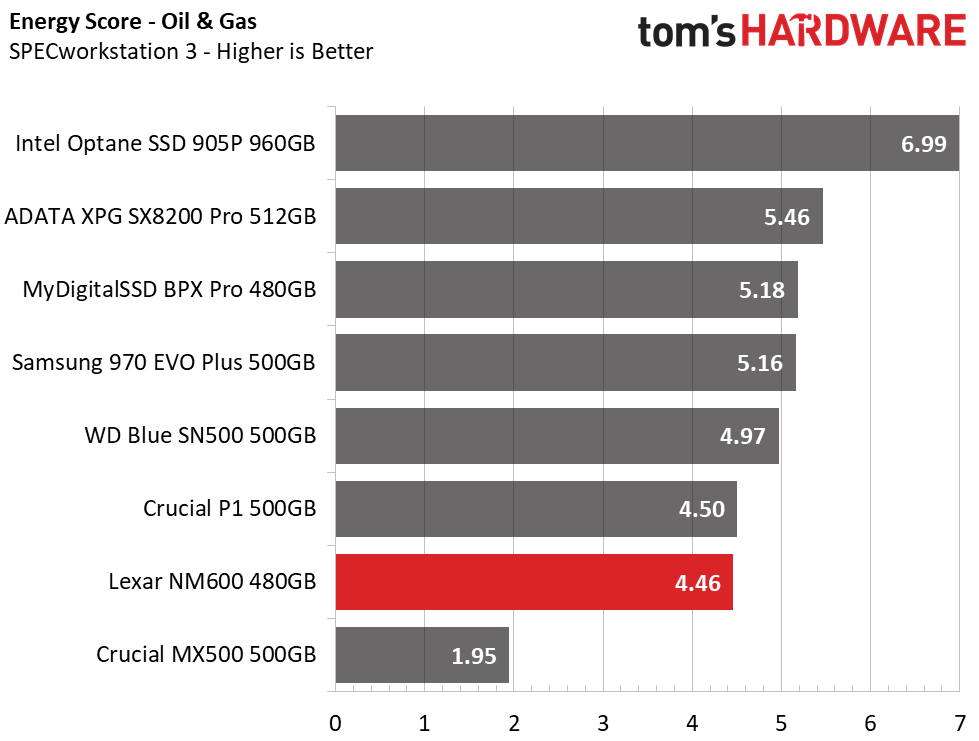
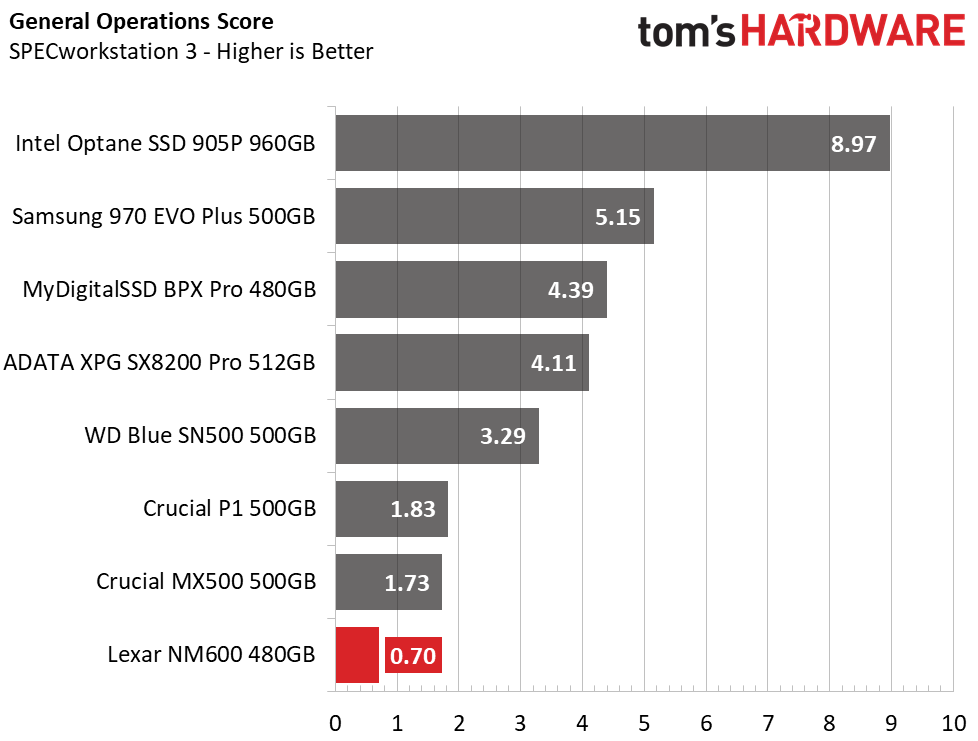
While the NM600 proved itself in light, consumer-like workloads, SPECworkstation 3 smacked its prosumer dreams with a heavy hand. Even with sequential performance that hits multi-gigabytes, this SSD scores lower than even the SATA based MX500 overall. For prosumer tasks, DRAM-based SSDs are the way to go.
Synthetic Testing - ATTO
ATTO is a simple and free application that SSD vendors commonly use to assign sequential performance specifications to their products. It also gives us insight into how the device handles different file sizes.


Out of the entry-level comparison drives, the NM600 has the best sequential read performance over various file sizes and hits nearly 2.1GBps read. Write performance lags slightly at smaller file sizes, however. Once the file size increases to 32KB and beyond, the NM600 maintains 1.65GBps throughput.
Synthetic Testing - iometer
iometer is an advanced and highly configurable storage benchmarking tool that vendors often use to measure the performance of their devices.


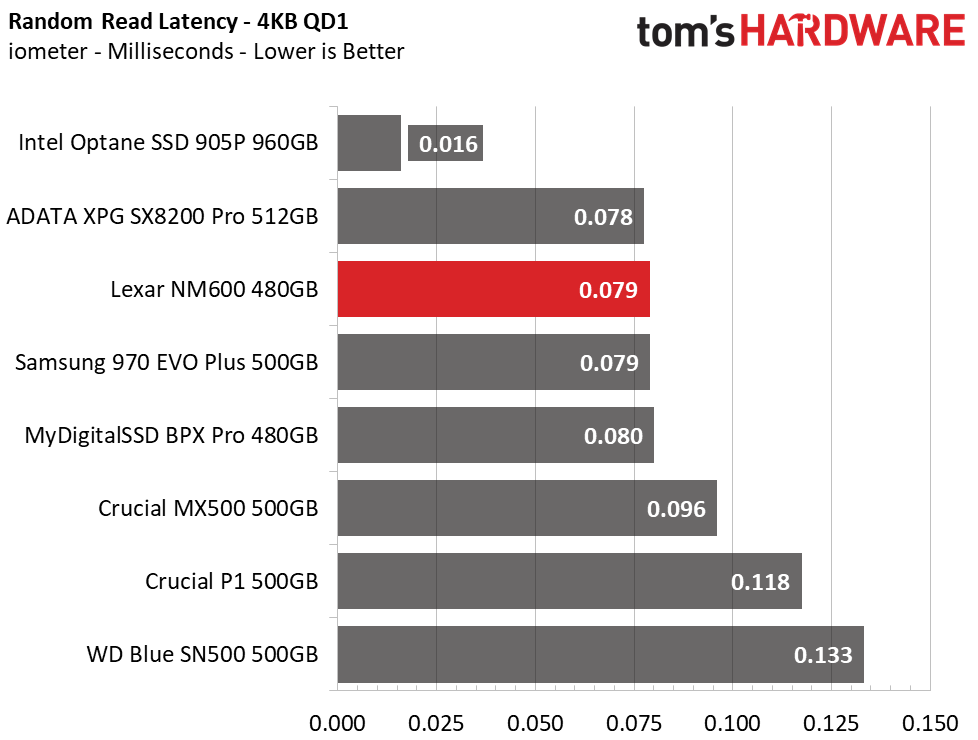



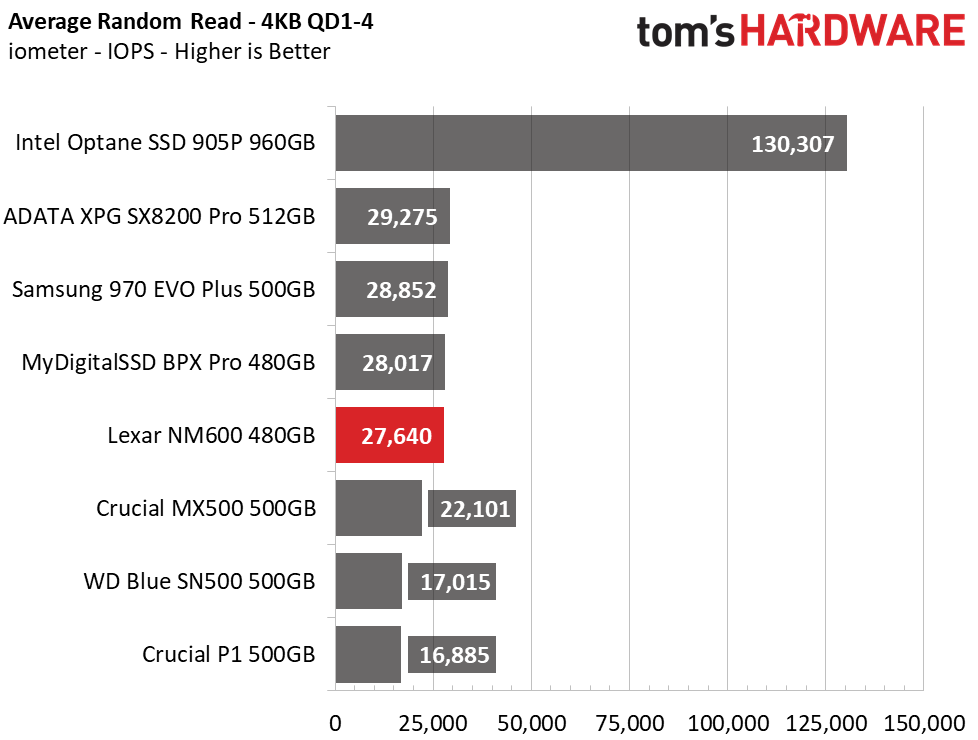



Our iometer testing reveals similar results as ATTO for sequential performance, up to 2.1/1.6GBps read/write, just as rated. Random reads at QD 1 match top-end competitors, but writes trail the NVMe- based competition. When averaging QD1-4, reads are again competitive and writes end up being lower than the MX500, hence the lower SPECworkstation 3 results we saw earlier. Peak random performance also exceeds the rated values from Lexar.
Sustained Sequential Write Performance
Official write specifications are only part of the performance picture. Most SSD makers implement a pseudo-SLC cache buffer, which is a fast area of SLC-programmed flash that absorbs incoming data. Sustained write speeds can suffer tremendously once the workload spills outside of the pSLC cache and into the "native" TLC or QLC flash. We use iometer to hammer the SSD with sequential writes for 15 minutes to measure both the size of the pSLC buffer and performance after the buffer is saturated.




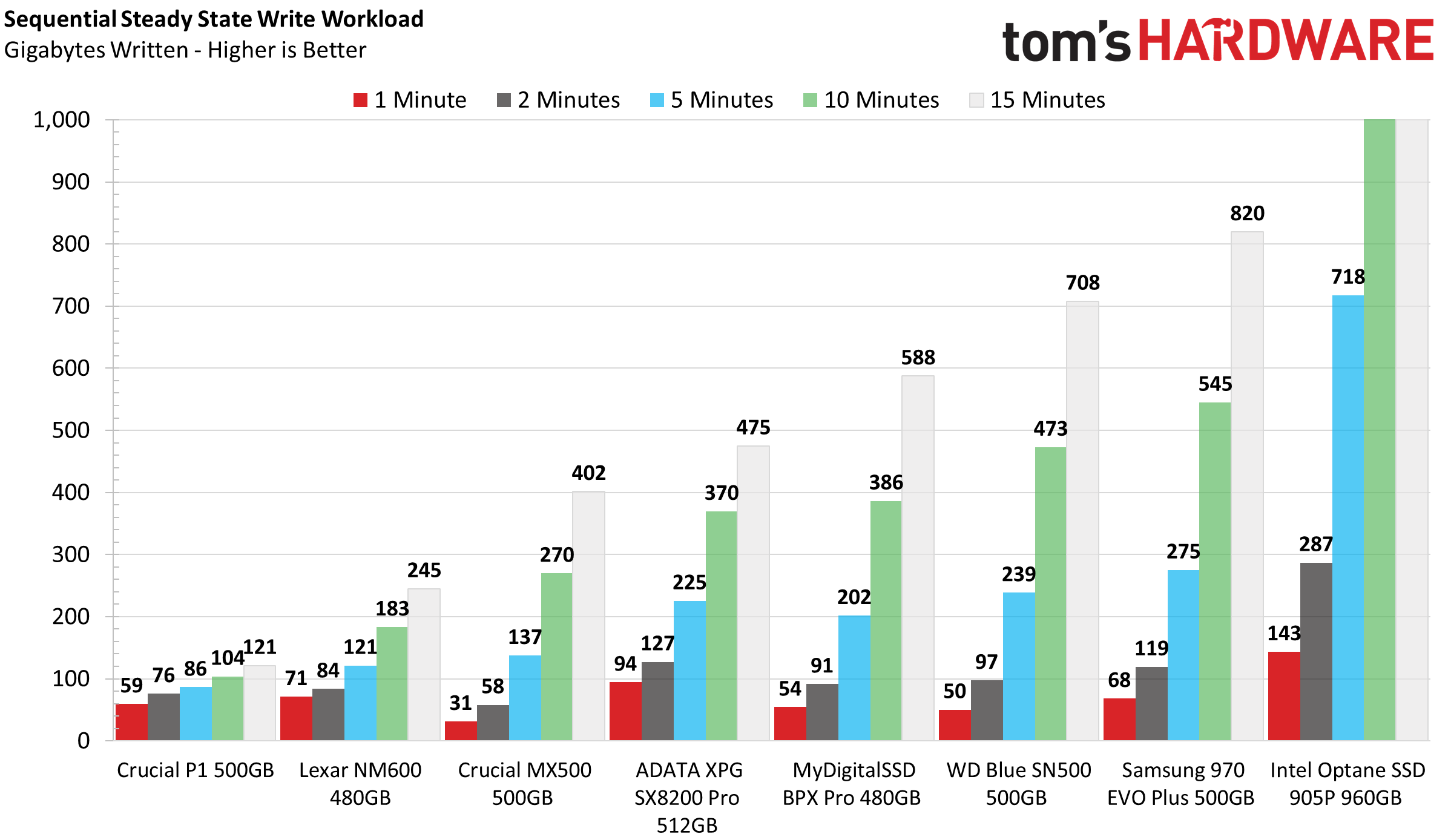
Lexar’s NM600 has a pSLC cache that seems to be about 67GB in size. After filling it, write performance degraded to an average rate of about 200MBps. Within the first minute of writing, the drive is able to outperform most competitors, but beyond that most competitors are able to out-write it. Overall, the Lexar drive outperforms the Crucial P1, which has QLC NAND, but it isn’t able to outperform the SATA-based MX500 after five minutes of sustained writing.
Power Consumption
We use the Quarch HD Programmable Power Module to gain a deeper understanding of power characteristics. Idle power consumption is a very important aspect to consider, especially if you're looking for a new drive for your laptop. Some SSDs can consume watts of power at idle while better-suited ones sip just milliwatts. Average workload power consumption and max consumption are two other aspects of power consumption, but performance-per-watt is more important. A drive might consume more power during any given workload, but accomplishing a task faster allows the drive to drop into an idle state faster, which ultimately saves power.

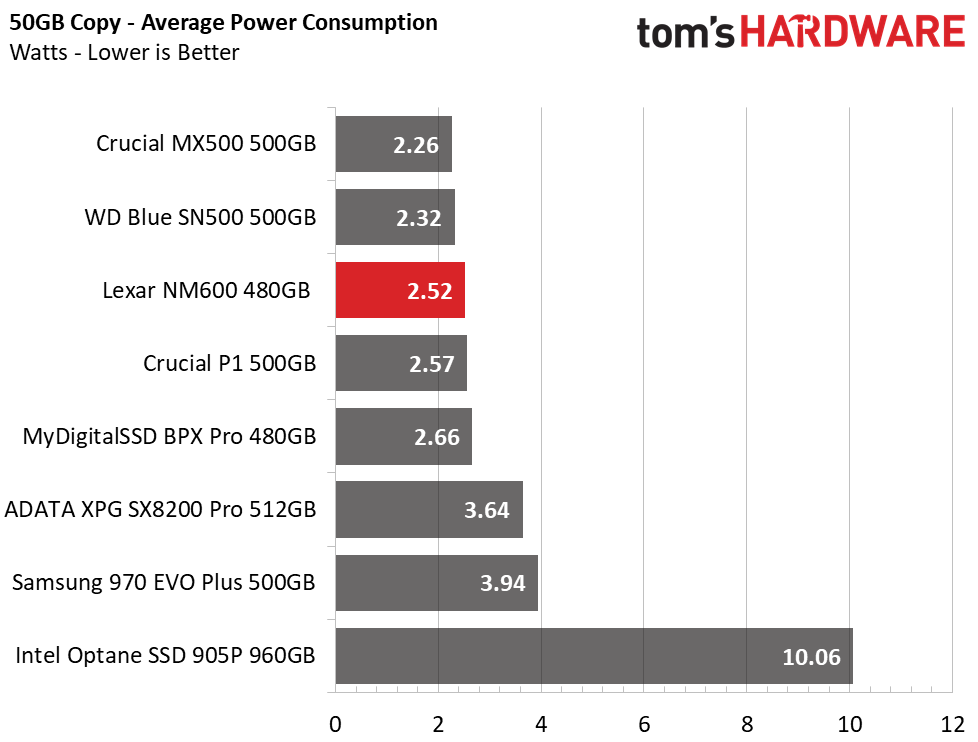

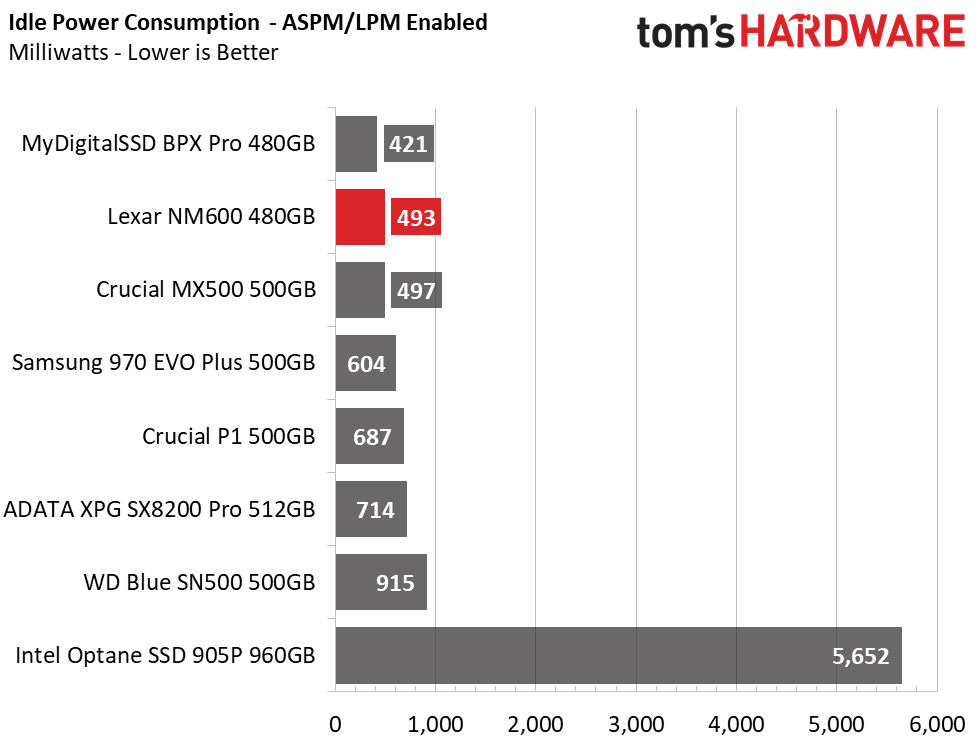

Like the ADATA XPG SX8200 Pro and WD Blue SN500, the Lexar NM600 is highly efficient in our 50GB file transfer test. It consumes a bit more than the WD consumes on average, but it consumes a watt less on average than the ADATA and most other competitors. At idle, HMB seems to add a bit to power consumption, but still, 147mW at idle is significantly less than a hard drive.
MORE: Best SSDs
MORE: How We Test HDDs And SSDs
MORE: All SSD Content

Sean is a Contributing Editor at Tom’s Hardware US, covering storage hardware.
-
bobalazs I like that you compared to WD Blue since that is what i bought for about the same price a few months ago, looks like i made the right choice.Reply

